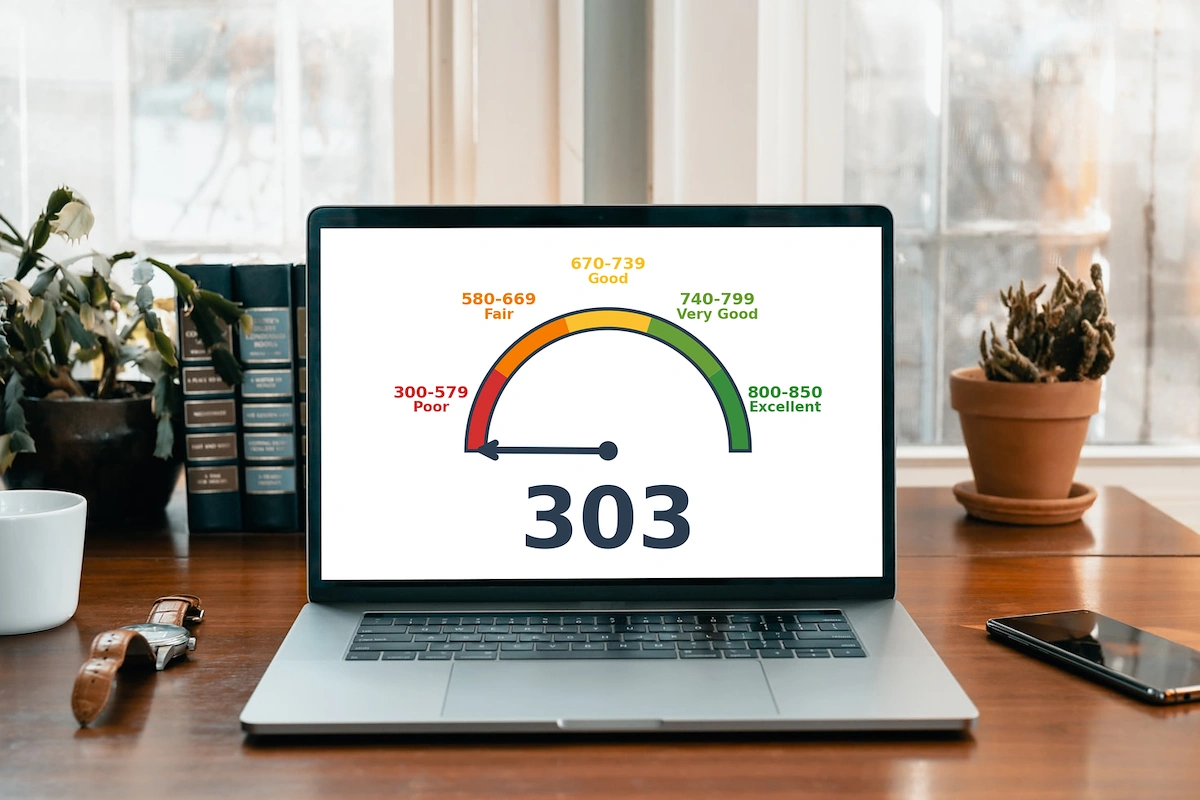
Kudos has partnered with CardRatings and Red Ventures for our coverage of credit card products. Kudos, CardRatings, and Red Ventures may receive a commission from card issuers. Kudos may receive commission from card issuers. Some of the card offers that appear on Kudos are from advertisers and may impact how and where card products appear on the site. Kudos tries to include as many card companies and offers as we are aware of, including offers from issuers that don't pay us, but we may not cover all card companies or all available card offers. You don't have to use our links, but we're grateful when you do!
303 Credit score: What You Need to Know in 2025
July 1, 2025


TL;DR
A 303 credit score indicates a significant opportunity for growth, setting a clear baseline from which to improve your financial standing. This score falls within the 'Poor' FICO® Score range, representing the foundational step on the path toward building excellent credit.
What Does a 303 Credit Score Mean?
A credit score of 303 places you at the very beginning of the FICO scoring range, which spans from 300 to 850. This score falls squarely into the "poor" category, signaling to lenders that you are a very high-risk borrower. Financially, this can create significant hurdles. You'll likely face rejections for new credit cards and loans, and any offers you do receive will probably come with extremely high interest rates and unfavorable terms, making borrowing very expensive.
While a 303 score reflects serious past credit challenges, it's not a permanent label. It represents a starting point from which you can move forward. Understanding the factors that led to this score is the first step on the path toward rebuilding your credit profile. With time and consistent effort, improving your financial standing is an achievable goal.
Who Has a 303 Credit Score?
While age isn't a direct factor in credit score calculations, there is a clear trend of scores improving over time. According to Experian data from 2023, average credit scores tend to rise with each generation:
- Generation Z (ages 18-26): 680
- Millennials (ages 27-42): 690
- Generation X (ages 43-58): 709
- Baby Boomers (ages 59-77): 745
- Silent Generation (ages 78+): 760
Credit Cards With a 303 Credit Score
A credit score of 303 falls into the “very poor” range, which can make qualifying for a traditional credit card a significant challenge. Most major issuers will view this score as a high risk, often resulting in an immediate denial for their most popular card offerings. Consequently, your options will likely be limited to secured credit cards or other products specifically designed to help individuals rebuild their credit history.
Kudos can help you find the best card for your situation with its AI-powered tools that analyze your financial preferences and spending habits. Using this information, the platform provides personalized recommendations and insights from a database of nearly 3,000 cards to help you find a suitable match for rebuilding your credit.
Auto Loans and a 303 Credit Score
A 303 credit score places you in the deep subprime category, which can make securing an auto loan challenging. While approval is still possible, you will likely face significantly higher interest rates and less favorable loan terms compared to borrowers with stronger credit histories.
According to a 2025 market analysis, here are the average auto loan interest rates broken down by credit score bracket:
- Super-prime (781-850): 5.25% for new cars and 7.13% for used cars
- Prime (661-780): 6.87% for new cars and 9.36% for used cars
- Non-prime (601-660): 9.83% for new cars and 13.92% for used cars
- Subprime (501-600): 13.18% for new cars and 18.86% for used cars
- Deep subprime (300-500): 15.77% for new cars and 21.55% for used cars
Mortgages at a 303 Credit Score
A 303 credit score is unfortunately too low to qualify for any standard mortgage. Lenders have minimum score requirements that are much higher; even the most accessible FHA loans require a score of at least 500 with a 10% down payment. Conventional, VA, and USDA loans typically require scores of 620 or higher, placing them well out of reach.
The primary impact of a 303 score on loan eligibility is outright denial from virtually all lenders. In the unlikely event you found a specialty subprime lender, the terms would be severe, including exceptionally high interest rates and a very large down payment to compensate for the risk.
What's in a Credit Score?
Figuring out what goes into your credit score can feel like trying to solve a complex puzzle, but it generally boils down to a handful of key elements. The most common factors include:
- Your history of making payments on time is the most significant factor.
- How much of your available credit you're currently using, known as your credit utilization ratio, plays a major role.
- The age of your credit accounts, including the average age and the age of your oldest account, is also considered.
- Lenders like to see that you can responsibly manage different types of credit, such as credit cards and loans.
- Opening several new credit accounts in a short period can be seen as a risk and may temporarily lower your score.
How to Improve Your 303 Credit Score
While a 303 credit score is near the lowest possible FICO® score, it is entirely possible to improve it with consistent effort. By adopting positive financial habits, you can see meaningful changes to your score in as little as three to six months.
- Monitor your credit reports. Regularly checking your reports helps you spot and dispute inaccuracies that could be dragging down your score. You can obtain free reports from all three major bureaus—Experian, TransUnion, and Equifax—through AnnualCreditReport.com.
- Establish automatic bill payments. Your payment history is the most significant factor in your credit score, so ensuring every bill is paid on time is critical. Setting up automatic payments is a simple way to build a positive payment history and avoid damaging late fees.
- Become an authorized user. Ask a trusted family member or friend with a strong credit history to add you as an authorized user on their credit card. This can add their positive payment history and low credit utilization to your report, which is especially helpful when rebuilding from a very low score.
- Apply for a secured credit card. A secured card requires a cash deposit as collateral, making it an accessible option for those with poor credit. Your payments are reported to the credit bureaus, allowing you to build a new line of positive credit history from scratch.
The free Kudos browser extension can help you manage your credit cards and spending to support your credit-building journey.

Supercharge Your Credit Cards
Experience smarter spending with Kudos and unlock more from your credit cards. Earn $20.00 when you sign up for Kudos with "GET20" and make an eligible Kudos Boost purchase.
Editorial Disclosure: Opinions expressed here are those of Kudos alone, not those of any bank, credit card issuer, hotel, airline, or other entity. This content has not been reviewed, approved or otherwise endorsed by any of the entities included within the post.




























.webp)
.webp)
.webp)
%20(1).webp)
.webp)


.webp)
.webp)
%20(1).webp)